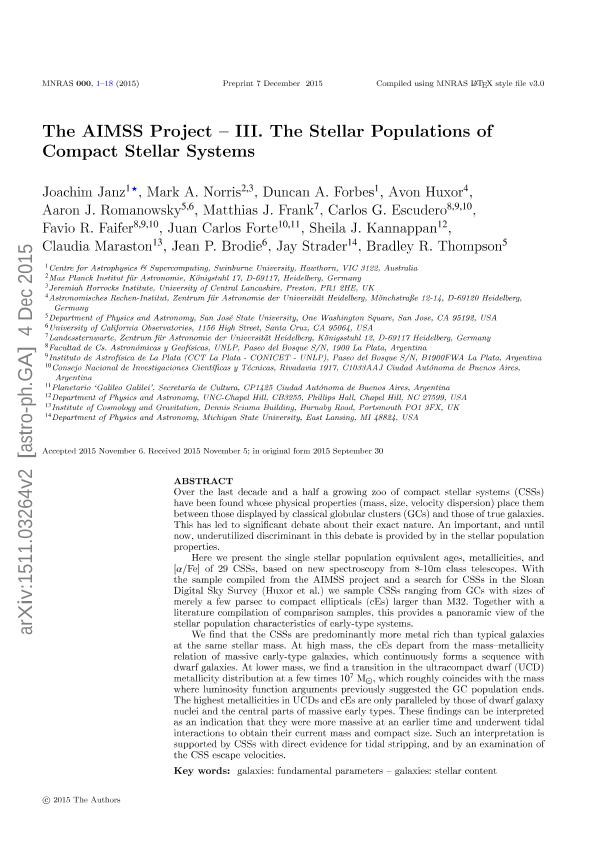Mostrar el registro sencillo del ítem
dc.contributor.author
Janz, Joachin
dc.contributor.author
Norris, Mark A.
dc.contributor.author
Forbes, Duncan A.
dc.contributor.author
Huxor, Avon
dc.contributor.author
Romanowsky, Aaron
dc.contributor.author
Frank, Matthias
dc.contributor.author
Escudero, Carlos Gabriel

dc.contributor.author
Faifer, Favio Raúl

dc.contributor.author
Forte, Juan Carlos

dc.contributor.author
Kannappan, Sheila J.
dc.contributor.author
Maraston, Claudia

dc.contributor.author
Brodie, Jean
dc.contributor.author
Strader, Jay
dc.contributor.author
Thompson, Bradley
dc.date.available
2018-02-07T15:10:12Z
dc.date.issued
2016-02
dc.identifier.citation
Janz, Joachin; Norris, Mark A.; Forbes, Duncan A.; Huxor, Avon; Romanowsky, Aaron; et al.; The AIMSS Project, III : the stellar populations of compact stellar systems; Wiley Blackwell Publishing, Inc; Monthly Notices of the Royal Astronomical Society; 456; 2-2016; 617-632
dc.identifier.issn
0035-8711
dc.identifier.uri
http://hdl.handle.net/11336/35941
dc.description.abstract
In recent years, a growing zoo of compact stellar systems (CSSs) have been found whose physical properties (mass, size, velocity dispersion) place them between classical globular clusters (GCs) and true galaxies, leading to debates about their nature. Here we present results using a so far underutilized discriminant, their stellar population properties. Based on new spectroscopy from 8-10m telescopes, we derive ages, metallicities, and [α/Fe] of 29 CSSs. These range from GCs with sizes of merely a few parsec to compact ellipticals (cEs) larger than M32. Together with a literature compilation, this provides a panoramic view of the stellar population characteristics of early-type systems. We find that the CSSs are predominantly more metal rich than typical galaxies at the same stellar mass. At high mass, the cEs depart from the mass-metallicity relation of massive early-type galaxies, which forms a continuous sequence with dwarf galaxies. At lower mass, the metallicity distribution of ultracompact dwarfs (UCDs) changes at a few times 10^7 M⊙, which roughly coincides with the mass where luminosity function arguments previously suggested the GC population ends. The highest metallicities in CSSs are paralleled only by those of dwarf galaxy nuclei and the central parts of massive early types. These findings can be interpreted as CSSs previously being more massive and undergoing tidal interactions to obtain their current mass and compact size. Such an interpretation is supported by CSSs with direct evidence for tidal stripping, and by an examination of the CSS internal escape velocities.
dc.format
application/pdf
dc.language.iso
eng
dc.publisher
Wiley Blackwell Publishing, Inc

dc.rights
info:eu-repo/semantics/openAccess
dc.rights.uri
https://creativecommons.org/licenses/by-nc-sa/2.5/ar/
dc.subject
Galaxies
dc.subject
Fundamental Parameters
dc.subject
Stellar Content
dc.subject.classification
Astronomía

dc.subject.classification
Ciencias Físicas

dc.subject.classification
CIENCIAS NATURALES Y EXACTAS

dc.title
The AIMSS Project, III : the stellar populations of compact stellar systems
dc.type
info:eu-repo/semantics/article
dc.type
info:ar-repo/semantics/artículo
dc.type
info:eu-repo/semantics/publishedVersion
dc.date.updated
2018-01-12T19:26:27Z
dc.journal.volume
456
dc.journal.pagination
617-632
dc.journal.pais
Reino Unido

dc.journal.ciudad
Londres
dc.description.fil
Fil: Janz, Joachin. Swinburne University; Australia
dc.description.fil
Fil: Norris, Mark A.. Gobierno de la Republica Federal de Alemania. Max Planck Institut Fur Astrophysik; Alemania
dc.description.fil
Fil: Forbes, Duncan A.. Swinburne University; Australia
dc.description.fil
Fil: Huxor, Avon. Universität Heidelberg; Alemania
dc.description.fil
Fil: Romanowsky, Aaron. San José State University; Estados Unidos
dc.description.fil
Fil: Frank, Matthias. Universität Heidelberg; Alemania
dc.description.fil
Fil: Escudero, Carlos Gabriel. Universidad Nacional de la Plata. Facultad de Ciencias Astronómicas y Geofísicas; Argentina. Consejo Nacional de Investigaciones Científicas y Técnicas. Centro Científico Tecnológico Conicet - La Plata. Instituto de Astrofísica La Plata. Universidad Nacional de La Plata. Facultad de Ciencias Astronómicas y Geofísicas. Instituto de Astrofísica la Plata; Argentina
dc.description.fil
Fil: Faifer, Favio Raúl. Universidad Nacional de la Plata. Facultad de Ciencias Astronómicas y Geofísicas; Argentina. Consejo Nacional de Investigaciones Científicas y Técnicas. Centro Científico Tecnológico Conicet - La Plata. Instituto de Astrofísica La Plata. Universidad Nacional de La Plata. Facultad de Ciencias Astronómicas y Geofísicas. Instituto de Astrofísica la Plata; Argentina
dc.description.fil
Fil: Forte, Juan Carlos. Gobierno de la Ciudad de Buenos Aires. Secretaria de Cultura. Subsecretaria de Patrimonio Cultural. Planetario ; Argentina. Consejo Nacional de Investigaciones Científicas y Técnicas; Argentina
dc.description.fil
Fil: Kannappan, Sheila J.. University of North Carolina; Estados Unidos
dc.description.fil
Fil: Maraston, Claudia. Institute of Cosmology snd Gravitation; Estados Unidos
dc.description.fil
Fil: Brodie, Jean. University of California; Estados Unidos
dc.description.fil
Fil: Strader, Jay. Michigan State University; Estados Unidos
dc.description.fil
Fil: Thompson, Bradley. San José State University; Estados Unidos
dc.journal.title
Monthly Notices of the Royal Astronomical Society

dc.relation.alternativeid
info:eu-repo/semantics/altIdentifier/doi/http://dx.doi.org/10.1093/mnras/stv2636
dc.relation.alternativeid
info:eu-repo/semantics/altIdentifier/url/https://academic.oup.com/mnras/article-abstract/456/1/617/1065825?redirectedFrom=fulltext
Archivos asociados
